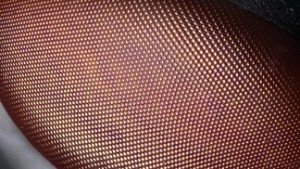Aug 13 2015
Inspired by the compound eyes of fruit flies, a team of researchers from EPFL has developed an artificial eye that allows robots to detect and avoid obstacles. From E-textiles to cars, the potentials applications are numerous.
 Creative Commons Aymen FANTAR
Creative Commons Aymen FANTAR
Is it possible to catch a fly? Small insects seem to possess a sixth sense that allows them to dodge any threats. Yet there is no magic trick, but only a compound eye that is an organ of vision made of thousands of ommatidia. These visual receptors allow insects to perceive precisely their environment, including the direction and speed of movements. Inspired by this natural model, the EPFL team, headed by Dario Floreano, has developed an artificial compound eye, described in a recent publication of Interface, a journal of the Royal Society.
The compound eyes of flies have many interesting properties. Each ommatidium is slightly offset from its neighbors, allowing the brain to collect and compare the information produced by the set of visual sensors. Insects can thus accurately perceive their environment and detect movement, even in dark places. All without spending a lot of energy.
A featherweight eye
These advantages have led several research teams to develop an artificial compound eye. Specifically, the sensor consists of three hexagonal photodetectors arranged in a triangular shape, covered with a single lens. The artificial eye is capable of operating the focus and to adapt to the ambient light. These three detectors, slightly offset, then send information to the microprocessor. Based on this flow, it will establish a summary map of the surrounding environment. "One must not imagine that this is a high quality image, explain Ramón Pericet Cámara, the project coordinator, it is only a three pixels picture." This figure may seem far too low, but it is sufficient for the artificial eye to detect surrounding objects and their motion vector. Better yet, the device also notices stationary objects through their relative velocity.
Despite measuring only 1925 * 475 * 860 microns (1 micron = 0.001 mm) and weighing only 2 mg, the electronic eye is capable of recording 300 frames per second, three times more than that of the fly. Moreover, it does not just capture the optical flow: it processes it directly and converts it from analog into digital.
Prevent collisions and help the blind
Such an eye has ideal attributes for equipping an unmanned aerial vehicle. "One of the project goals was to develop a sensor for very small drones”, says Ramón Pericet Cámara. “To be relatively autonomous, these flying robots must be able to detect and avoid their surroundings. The biggest challenge was to miniaturize all the components", he added. Like its animal counterpart, the electronic eye is very energy efficient. It may also be attached on all sorts of structures, whether rigid, soft, planar or curved.
All these advantages open the way to multiple applications. Beyond its integration into drones built for rescue or surveillance tasks, the artificial eye could be used in many other sectors. For instance, EPFL teams are currently developing a connected cap to help the blind: visual sensors detect obstacles and guide the wearer via a system of vibrations. It is also possible to imagine automotive applications, either to optimize the operation of unmanned cars or prevent collisions.
Ramón Pericet Cámara notes that the success of this project wouldn’t have been possible without the participation of several partner universities. "To arrive at such a result, we had to bring together the best European experts available. Such a project is unachievable in a single institution. "